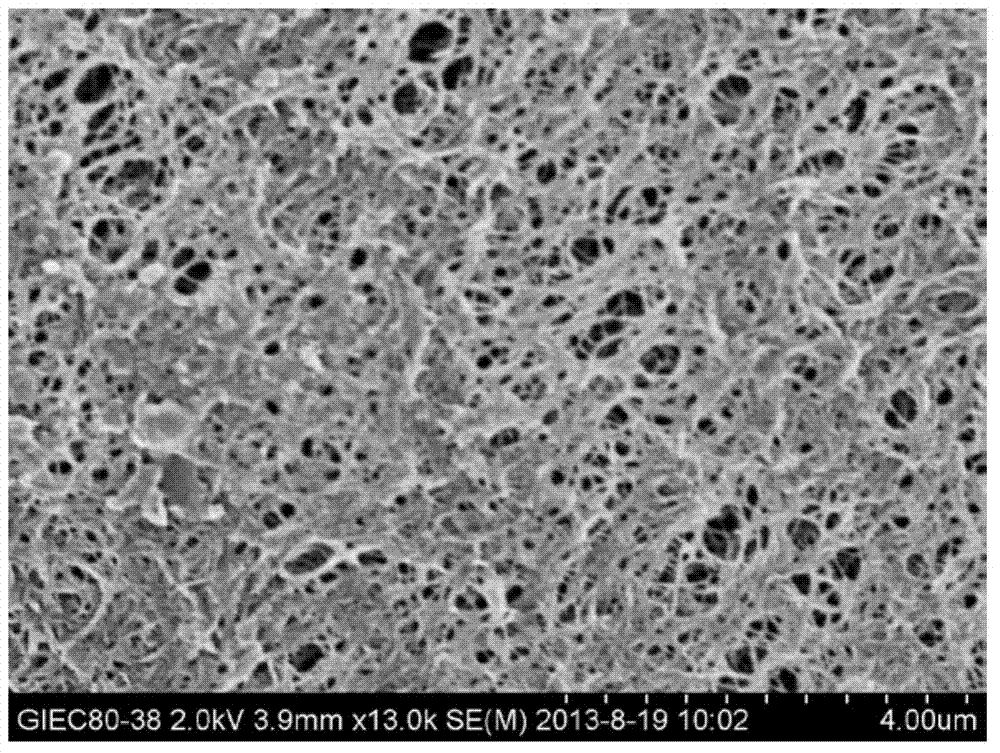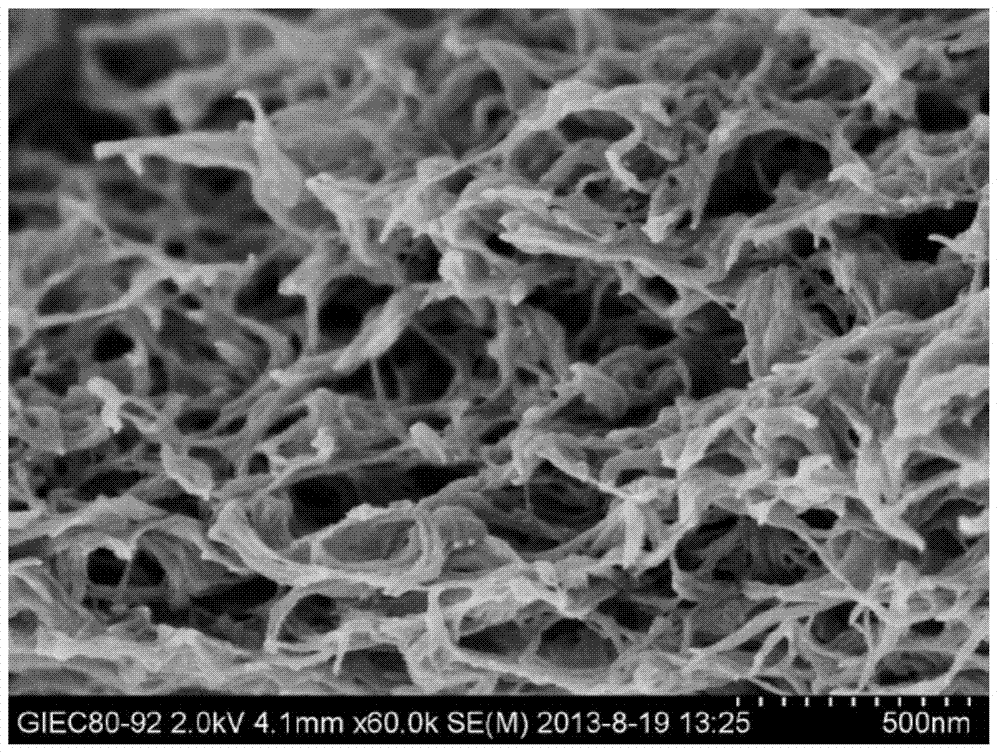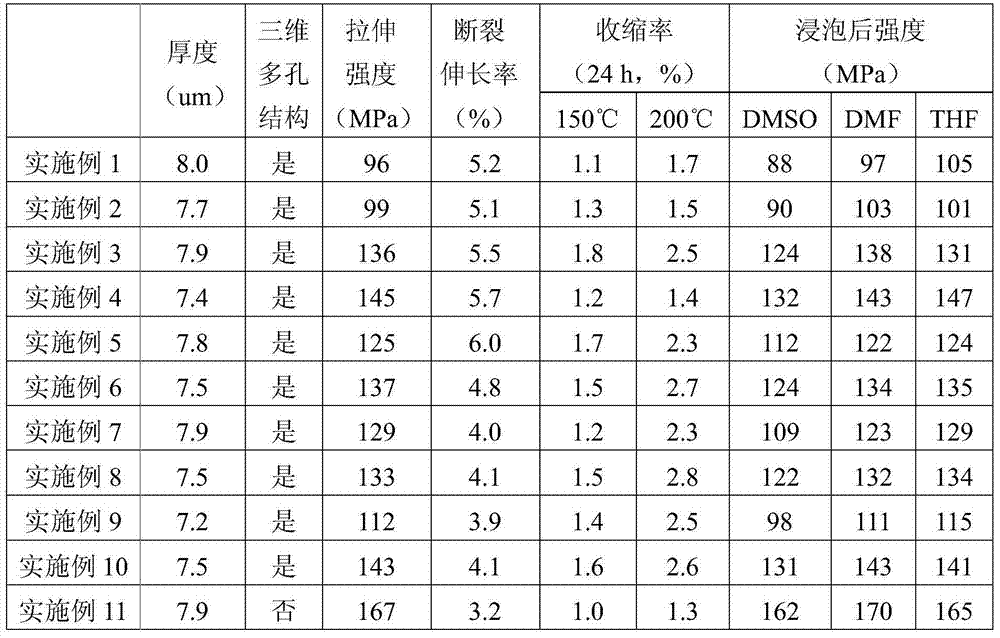Kevlar nano fiber porous membrane, and preparation method and application thereof
A nanofiber and porous membrane technology, applied in the field of fiber membranes, can solve the problems of reducing the strength of para-aramid fibers, and achieve the effects of high strength, good high temperature resistance and short process.
- Summary
- Abstract
- Description
- Claims
- Application Information
AI Technical Summary
Problems solved by technology
Method used
Image
Examples
Embodiment 1
[0045] Embodiment 1: Preparation of high-strength, high-temperature-resistant, solvent-resistant Kevlar nanofiber porous membrane
[0046](1) Add 16 parts by weight of Kevlar fibers (provided by Dupont), 16 parts by weight of potassium hydroxide, and 200 parts by weight of dimethyl sulfoxide into a round bottom flask, and stir at 25°C for 10 days to form uniform, transparent black-red Kevlar nanofibers. Methyl sulfoxide solution.
[0047] (2) Put 1 weight part of PEG-200 into the Kevlar solution prepared in (1), and stir for 2-10 hours to form a uniform casting solution. The casting solution was vacuum degassed for 2 hours before use.
[0048] (3) Scrape the film-casting solution on a clean glass plate with a scraper to form a 100um thick film, evaporate the solvent at 50°C for 5 minutes, sink into distilled water to form a gel film. The gel film was soaked in distilled water for 8-24 hours until the solvent was completely removed, and then placed in a vacuum oven for 2 hour...
Embodiment 2
[0051] Embodiment 2: Preparation of high-strength, high-temperature-resistant, solvent-resistant Kevlar nanofiber porous membrane
[0052] (1) Add 15 parts by weight of Kevlar, 15 parts by weight of potassium hydride, and 200 parts by weight of N,N-dimethylformamide (DMAC) into a round bottom flask, and stir at 50°C for 2 days to form a uniform, transparent black-red Kevlar nanofiber DMAC solution.
[0053] (2) Put 5 parts by weight of PVP-15 into the Kevlar solution prepared in (1), and stir for 2-12 hours to form a uniform casting solution. The casting solution is vacuum degassed for 2 to 4 hours before use.
[0054] (3) Scrape the film-casting solution on a clean glass plate with a scraper to form a 120um thick film, evaporate the solvent at 70°C for 4 minutes, sink into distilled water to form a gel film. The gel film was soaked in distilled water for 8-24 hours until the solvent was completely removed, and then placed in a vacuum oven for 2 hours at 60°C and 2 hours at ...
Embodiment 3
[0057] Embodiment 3: Preparation of high-strength, high-temperature-resistant, solvent-resistant Kevlar nanofiber porous membrane
[0058] (1) Add 16 parts by weight of Kevlar, 8 parts by weight of sodium hydride, and 200 parts by weight of N,N-dimethylacetamide (DMF) into a round bottom flask, and stir at 40°C for 4 days to form a uniform, transparent black-red Kevlar nanofiber DMF solution.
[0059] (2) Put 7 parts by weight of PEG-2000 into the Kevlar solution prepared in (1), and stir for 2-10 hours to form a uniform casting solution. The casting solution is vacuum degassed for 2 to 4 hours before use.
[0060] (3) Use a spatula to scrape the film casting solution on a clean glass plate to form a 100um thick film, evaporate the solvent at 80°C for 3 minutes, and sink into a solution with a volume ratio of distilled water / ethanol of 50 / 50 to form a gel film. The gel film was soaked in distilled water for 8-24 hours until the solvent was completely removed, then placed in ...
PUM
 Login to View More
Login to View More Abstract
Description
Claims
Application Information
 Login to View More
Login to View More - R&D
- Intellectual Property
- Life Sciences
- Materials
- Tech Scout
- Unparalleled Data Quality
- Higher Quality Content
- 60% Fewer Hallucinations
Browse by: Latest US Patents, China's latest patents, Technical Efficacy Thesaurus, Application Domain, Technology Topic, Popular Technical Reports.
© 2025 PatSnap. All rights reserved.Legal|Privacy policy|Modern Slavery Act Transparency Statement|Sitemap|About US| Contact US: help@patsnap.com



